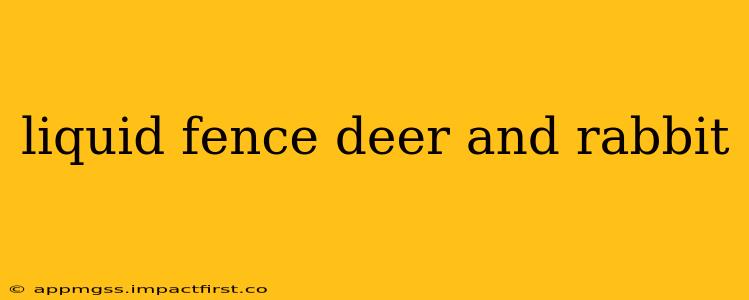Liquid Fence is a popular brand of deer and rabbit repellent, promising to keep unwanted critters away from your precious garden and landscaping. But does it really work? This comprehensive guide delves into the effectiveness, application, ingredients, and alternatives of Liquid Fence deer and rabbit repellent, answering all your burning questions.
What is Liquid Fence Deer and Rabbit Repellent?
Liquid Fence is a concentrated repellent designed to deter deer, rabbits, and other small mammals from damaging your plants and property. It works by utilizing a strong-smelling formula that animals find unpleasant, discouraging them from browsing in treated areas. The product is available in various forms, including ready-to-use sprays and concentrates that can be diluted with water. Its popularity stems from its relatively easy application and wide availability at garden centers and home improvement stores.
Does Liquid Fence Really Work?
This is the million-dollar question. The effectiveness of Liquid Fence, like many animal repellents, varies depending on several factors:
- Animal behavior: Animals can habituate to repellents, meaning they eventually get used to the smell and ignore it. Consistent reapplication is crucial for ongoing protection.
- Environmental conditions: Rain and heavy watering can wash away the repellent, requiring more frequent applications. Strong winds can also disperse the scent, reducing its effectiveness.
- Scent sensitivity: Some animals are more sensitive to the repellent's scent than others. Deer, for example, have a very sensitive sense of smell, but their response can differ depending on individual animals and their level of hunger.
- Application method: Proper application is vital. Following the instructions on the product label ensures adequate coverage and optimal results.
While Liquid Fence isn't a guaranteed solution to eliminate all animal damage, many users report positive experiences, especially when used proactively and consistently. It is most effective when used in combination with other deterrents.
What are the Ingredients in Liquid Fence?
Liquid Fence's exact formulation varies slightly depending on the specific product, but generally includes a blend of natural and synthetic ingredients designed to create an unpleasant odor and taste for animals. These ingredients typically include:
- Putrescent egg solids: This is a common ingredient in many animal repellents and contributes to the strong odor.
- Other natural and synthetic ingredients: The exact nature of these ingredients varies depending on the formulation, but they usually enhance the unpleasant smell and taste.
The specific components aren't always publicly listed, but you can usually find information on the product label.
How Do I Apply Liquid Fence?
Application instructions vary depending on the product type (concentrate or ready-to-use). Always refer to the instructions on the product label for detailed guidance. Generally, you will need to:
- Prepare the area: Clear away any debris or obstacles that may interfere with application.
- Mix (if necessary): If using a concentrate, dilute it with water according to the instructions.
- Apply: Use a garden sprayer to apply the repellent evenly to the plants, shrubs, or other areas you want to protect. Be sure to coat leaves and stems thoroughly.
- Reapply: Reapply the repellent after rain or heavy watering, and regularly according to the label's recommendation.
How Often Should I Reapply Liquid Fence?
Reapplication frequency depends on several factors, including weather conditions and animal activity. Expect to reapply after heavy rainfall or watering. The manufacturer's recommendations should be followed carefully, as consistent application is crucial for optimal results. Generally, weekly or bi-weekly applications may be necessary, especially during periods of heavy rain or intense animal activity.
Are There Any Alternatives to Liquid Fence?
Yes, there are numerous alternative deer and rabbit repellents available on the market, including:
- Other commercial repellents: Many companies produce repellents using various ingredients and application methods.
- Homemade repellents: Several DIY recipes use readily available household ingredients like garlic, onions, hot peppers, and soap.
- Physical barriers: Fencing, netting, or other physical barriers can provide a more reliable solution.
It's best to research different options and select the method that best suits your needs and budget.
Is Liquid Fence Safe for People, Pets, and Plants?
Liquid Fence is generally considered safe for humans, pets, and plants when used according to label instructions. However, it’s always best to keep children and pets away from treated areas while the repellent is wet. Avoid contact with skin and eyes, and wash thoroughly after application. Always consult the product label for detailed safety information.
What if Liquid Fence Doesn't Work?
If Liquid Fence proves ineffective, consider combining it with other deterrents or exploring alternative repellents or physical barriers. Remember that no single repellent is foolproof, and a multi-pronged approach often yields the best results. Persistent animals may require more robust deterrents.
By following these guidelines and understanding the limitations of any repellent, you can increase your chances of protecting your garden from hungry deer and rabbits. Remember that consistent application and a combination of deterrents are usually the most effective strategy.
